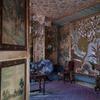CHRISTIE’S TO OFFER ONE OF THE MOST IMPORTANT COLLECTIONS OF MODERN INDIAN WORKS- THE ART OF NANDALAL BOSE, ABANINDRANATH TAGORE, AND RABINDRANATH TAGORE: THE COLLECTION OF SUPRATIK BOSE
- NEW YORK, New York
- /
- September 11, 2013
New York - On September 17, Christie’s New York is pleased to present The Art of Nandalal Bose, Abanindranath Tagore, and Rabindranath Tagore: The Collection of Supratik Bose, a single-owner sale of 81 exceptional modern Indian works of art. These works are coming to the auction market for the very first time from the collection of Supratik Bose, Nandalal Bose’s grandson. As a retired architect and officer of Harvard University, Mr. Bose’s collection also includes works by Rabindranath Tagore, the father of arts education in India, and Abanindranath Tagore, his nephew and fellow artist. The depth of his collection reflects Supratik Bose’s heritage and passion for early Indian modernism.
Hugo Weihe, Christie's International Director of Asian Art, said: “We are deeply honored to have been entrusted by Supratik Bose to handle this extraordinary collection that his grandfather Nandalal Bose handed down to him. It documents the shared vision of three artistic geniuses, who are linked by the common goal of art and humanity, family and friendship.”
Nandalal Bose (1882-1966)
Born in Bihar, Nandalal was one of many artists who wanted to revive Indian art after centuries of British influence. Over the next few decades, Bose experimented with a variety of Indian, Japanese and Chinese techniques and his works intersected with many of the cultural and political movements of his time such as Pan-Asianism and the Swadeshi movement led by Mohandas K. Gandhi. It was his portrayal of rural India that captured Gandhi’s attention. Although Bose’s art was not overtly political, Gandhi saw in the images a traditional India that reflected his nonviolent movement. To mark the 1930 occasion of Gandhi's arrest for protesting the British tax on salt, Bose created a black on white linocut of Gandhi walking with a staff. It became the most iconic image of India’s nationalist movement. Gandhi later commissioned Bose to create posters for the 1938 Indian National Congress meeting in Haripura. Four of these posters will be offered, including the Bull Handler (illustrated on page one), which is the sale’s cover lot.
Bose studied under Abanindranath Tagore (1871-1951) and was deeply influenced by Rabindranath Tagore (1861-1941), with whom he travelled to China and Japan in 1924. Through art and education, Bose made a unique contribution to the cultural regeneration and independence of India and received many awards including the Padma Vibhushan in 1954 and was honored with the title of Deshikottama. In 2008, the San Diego Museum of Art in collaboration with the National Gallery of Art, New Delhi organized the first major retrospective exhibition for Nandalal Bose outside of Asia, bringing his works to an American audience for the first time.
Together these three artistic geniuses sought freedom and independence not just for their art, but for their country. Their life and work embodies the universal spirit of liberation - of the mind, the body, and the brush - and is a testament to the boundless power of art in uniting humanity. Among the sale’s highlights is a handwritten poem by Rabindranath Tagore which was published in Gitanjali, for which Tagore became the first Asian to win the Nobel Prize in Literature, 1913. There is also a lovely collection of postcards shared between Abanindranath Tagore and Bose that speaks of their friendship, the intimacy and admiration they had for each other. Works by Abanindranath Tagore, such as his captivating Siva- Simantini demonstrate the seamless existence of the past and present in modern Indian art.




10270x400_c.jpg)

















